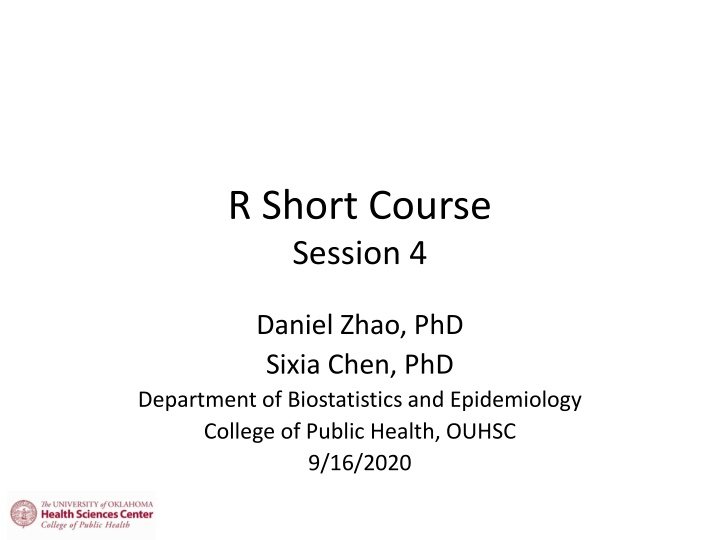
Short Course Session 4: Random Distributions and Statistical Tests
Explore random distributions including Normal, Chi-Square, t-distribution, Exponential, Uniform, Bernoulli, and Binomial. Learn about summary statistics, statistical tests, and power analysis in this informative session held by Daniel Zhao, PhD, and Sixia Chen, PhD from the Department of Biostatistics and Epidemiology at OUHSC.
Download Presentation

Please find below an Image/Link to download the presentation.
The content on the website is provided AS IS for your information and personal use only. It may not be sold, licensed, or shared on other websites without obtaining consent from the author. If you encounter any issues during the download, it is possible that the publisher has removed the file from their server.
You are allowed to download the files provided on this website for personal or commercial use, subject to the condition that they are used lawfully. All files are the property of their respective owners.
The content on the website is provided AS IS for your information and personal use only. It may not be sold, licensed, or shared on other websites without obtaining consent from the author.
E N D
Presentation Transcript
R Short Course Session 4 Daniel Zhao, PhD Sixia Chen, PhD Department of Biostatistics and Epidemiology College of Public Health, OUHSC 9/16/2020
Outline Random distributions Summary statistics Statistical tests Power analysis
Random distributions Normal distribution: dnorm(x,mean=0,sd=1): density function evaluated at x pnorm(q,mean=0,sd=1): CDF value at q qnorm(p,mean=0,sd=1): quantile function (pth) rnorm(n,mean=0,sd=1): generate data with sample size n
Random distributions (2) Chi-Square distribution: dchisq(x,df,ncp=0): df is degrees of freedom, ncp is non-centralized parameter pchisq(q,df,ncp=0) qchisq(p,df,ncp=0) rchisq(n,df,ncp=0)
Random distributions (3) t distribution: dt(x,df,ncp) pt(q,df,ncp) qt(p,df,ncp) rt(n,df,ncp)
Random distributions (4) Exponential distribution: dexp(x,rate=1): rate is lambda parameter defined in exponential distribution pexp(q,rate=1) qexp(p,rate=1) rexp(n,rate=1)
Random distributions (5) Uniform distribution: dunif(x,min=0,max=1) punif(q,min=0,max=1) qunif(p,min=0,max=1) runif(n,min=0,max=1)
Random distributions (6) Bernoulli distribution: Install package Rlab dbern(x,prob): prob is the probability of getting event pbern(q,prob) qbern(p,prob) rbern(n,prob)
Random distributions (7) Binomial distribution: dbinom(x,size,prob): size and prob are n (sample size) and p (probability for event) parameters defined in binomial distribution pbinom(q,size,prob) qbinom(p,size,prob) rbinom(n,size,prob)
Random distributions (8) Simple random sample with replacement: sample(x,size,replace=T) #size: number of obs to be drawn Simple random sample without replacement: sample(x,size,replace=F)
Summary Statistics Mean: mean(x,trim=0,na.rm=F) Variance: var() Standard deviation: sd() Quantile: quantile(x,probs=c(0.1,0.5)) Median: median() Inter quantile range: IQR()
Summary Statistics (2) Maximum value: max() Minimum value: min() General summary statistics: summary() cov(x,y) #covariance between x and y cor(x,y) #correlation between x and y Order statistics: sort(x)
Statistical tests (t tests) t.test(x,y=NULL,alternative=c( two.sided , less , g reater ),mu=0,paired=FALSE,var.equal=FALSE,con f.level=0.95, ) #x: a (non-empty) numeric vector #y: an optional (non-empty) numeric vector #alternative: type of hypothesis #mu: true value of the mean or difference #paired: paired t test or not #var.equal: assume equal variance or not #conf.level: confidence level of interval
t tests (One sample) x<-rnorm(100); y<-rnorm(200,mean=1,sd=1) t.test(y,mu=1) Results:
t tests (Two sample) t.test(x,y)
t tests (Two group) z<-c(x,y);g<-c(rep(1,length(x)),rep(2,length(y))) t.test(z~g)
t tests (Paired) e1<-rnorm(100) e2<-rnorm(100) u<-rnorm(100) y1<-1+u+e1 y2<-2+u+e2
t tests (Paired) (2) t.test(y1,y2,paired=TRUE)
Statistical tests (tests for equality of two variances) F test (normal distribution): var.test(x,y,ratio=1, alternative=c( two.sided , less , greatere ),co nf.level=0.95, ) Bartlett test (equality of variances for each of the groups): Bartlett.test(x,g) #x is the study variable, #g is the group identification variable
F tests (Example) var.test(x,y)
Bartlett test (Example) bartlett(z,g)
Statistical tests (Wilcoxon test) wilcox.test(x,y=NULL,alternative=,mu=0,paired =FALSE, ) #the input parameters are similar as that for t.test. It can perform one sample, two sample and paired tests
Wilcoxon test (example) One sample test: wilcox.test(y,mu=1)
Wilcoxon test (example) (2) Two sample test: wilcox.test(x,y)
Statistical tests (Test normality) Shapiro-Wilk test: shapiro.test(x) Anderson-Darling normality test: ad.test(x) Cramer-von Mises test: cvm.test(x) Kolmogorov-Smirnov test: lillie.test(x) #Note that the last three tests require using package nortest
Test normality (Example) shapiro.test(x) ad.test(x)
Statistical tests (Kolmogorov-Smirnov test) ks.test(x,y,alternative= ) #Kolmogorove-Smirnov test is used to test the equality of two distributions Example: ks.test(x,y)
Statistical tests (Chi Squared Test) Input data: survey in package MASS Variables: Smoke: how much the student smokes Exer: how much the student exercises Statistical Goal: test independence between Smoke and Exer
Chi Squared Test library(MASS) tbl = table(survey$Smoke, survey$Exer) tbl # the contingency table # load the MASS package Freq None Some Heavy 7 Never 87 18 84 Occas 12 Regul 9 1 3 3 4 1 7
Chi Squared Test (2) chisq.test(tbl)
Statistical tests (Fishers exact test) fisher.test(tbl)
Statistical tests (Correlation) cor.test(x,y,alternative=,method=c( pearson , kendall , spearman ), ) #x,y: numeric vectors of data values. x and y must have the same length
Correlation (Example) cor.test(y1,y2)
Statistical tests (Pairwise t tests) pairwise.t.test(x,g,p.adj=,pool.sd=,paired=,alte rnative=, ) #x is the response vector #g is grouping vector or factor #p.adj is the method for adjusting p values c( holm , hochberg , bonferroni ) #pool.sd denotes whether you want the pooled sd or not
Pairwise t tests (Example) a1<-rnorm(100);a2<-rnorm(100) a3<-rnorm(100,1,1);a<-c(a1,a2,a3) g<-c(rep(1,100),rep(2,100),rep(3,100)) pairwise.t.test(a,g,p.adj="bonferroni")
Power analysis R package pwr Functions: pwr.2p.test: two proportions (equal n) pwr.2p2n.test: two proportions (unequal n) pwr.p.test: proportion (one sample) pwr.t.test: t-tests (one sample, 2 sample, paired) pwr.t2n.test: t-test (two samples with unequal n)
Two proportions (equal n) pwr.2p.test(h=NULL,n=NULL,sig.level=0.05,po wer=NULL,alternative=c( two.sided , less , gr eater )) #h: Effect size #n: Number of observations (per sample) #power: Power of test Exactly one of the parameters h , n , power and sig.level must be passed as NULL and that parameter is determined from the others
Two proportions (equal n) (Example) pwr.2p.test(h=0.3,n=80,sig.level=0.05,alternati ve="greater")
Two sample t test (equal n) pwr.t.test(n=NULL,d=NULL,sig.level=0.05,pow er=NULL,type=c( two.sample , one.sample , p aired ),alternative=) #d: Effect size #type: type of test Exactly one of the parameters d , n , power and sig.level must be passed as NULL, and that parameter is determined from the others
Two sample t test (equal n) (Example) pwr.t.test(d=0.3,power=0.75,sig.level=0.05,typ e= two.sample ,alternative= greater )






















